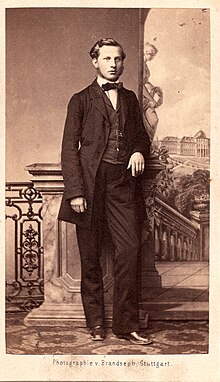Ferdinand Haug
Ferdinand Friedrich Ludwig Haug (born December 21, 1837 in Sindelfingen , Kingdom of Württemberg ; † June 21, 1925 in Stuttgart , People's State of Württemberg ) was a Württemberg scholar , archaeologist and classical philologist . Haug taught classical languages at the Grand Ducal Gymnasium in Mannheim until his retirement. He was a researcher in the field of Roman finds on the Limes . The city of Mannheim had become the center of his life.
family
Ferdinand Friedrich Ludwig Haug is the son of Ferdinand Haug senior (1807–1864), dean in Leonberg since 1843, and his wife Charlotte, née Faber (1816–1902). He is a grandson of Gottlob Friedrich Haug and his wife Juliane Luise Märklin and a nephew of the historian Carl Friedrich Haug . He has numerous ancestors from Württemberg honorableness . He is also a descendant of the reformer Johannes Brenz .
Ferdinand Haug junior married Klothilde Rall (1842–1898) on February 4, 1867 in Reutlingen . In the marriage four children were born, the daughters Emilie (1868-1943) and Helene (1870-1958) and the sons Alfred (1873-1929) and Wilhelm (1882-1901). The son Alfred Haug studied law in Heidelberg and Berlin and was German consul in Zanzibar .
Life
Ferdinand Haug studied Protestant theology at the University of Tübingen from 1855 to 1859 and received a scholarship from the Evangelical Foundation , from 1859 to 1861 he studied philology in Tübingen, Berlin and Bonn. After his first years as a clergyman in Württemberg (1861 representation in Reutlingen , 1863 repetition at the Evangelical monastery in Tübingen, 1867 deacon in Weinsberg ), Haug became a teacher at the Grand Ducal High School in Mannheim in 1873 . In 1876 he went to the grammar school in Konstanz as headmaster before he returned to Mannheim in 1881 in the same position. In 1906 he retired. In Constance he represented the Grand Duchy of Baden on the board of the Association for the History of Lake Constance and its surroundings . In Mannheim he also looked after the Grand Ducal Antiquarium and was a member of the board of the antiquity association . In 1900 Haug was given the title of Privy Councilor , and in 1917 the title of Privy Councilor .
Together with Gustav Sixt, Ferdinand Haug published the book Die Roman Insschriften und Bildwerke Württembergs (1st edition 1900, 2nd edition with Peter Goessler 1914). Haug also wrote articles for the realcyclopedia of classical antiquity .
After his retirement Ferdinand Haug in 1906 from the University of Heidelberg , the honorary doctorate awarded for his contributions to the study of Baden and Württemberg early history. The Mannheim Antiquities Association named Haug an honorary member.
Ferdinand Haug died in Stuttgart, where he moved in 1909 after his active professional life and lived in his daughter's house; he reached the old age of 88 years. It was Haug's express wish in Mannheim, the place where he worked as a high school teacher and researcher, to be laid to rest in the main cemetery .
Publications
- The Roman memorial stones of the Grand Ducal Antiquarium in Mannheim . Mannheim 1877 ( digitized version ).
- Arbon in Roman times and the Roman roads leading through Arbon . In: Writings of the Association for the History of Lake Constance and its Surroundings 10, 1880 ( digitized version )
- The Roman border wall in Germany . Mannheim 1885
- with Gustav Sixt : The Roman inscriptions and sculptures of Württemberg . Kohlhammer, Stuttgart 1st edition 1900 ( digitized version ); 2nd edition 1914; Reprinted 1970.
Individual evidence
- ^ Carl Friedrich Haug: Communications from his life and from his estate, printed as a manuscript for relatives and friends . Edited by Karl Riecke . Stuttgart. Printed by IB Metzler'schen Buchdruckerei. 1869.
- ↑ Dieter Heinze: Ferdinand Haug Streiter for the grammar school, master of epigraphy and antiquity, a Mannheim life picture . In: Mannheimer Hefte . Year 1991, p. 117.
- ↑ Who is it? Our contemporaries . Edited by Herrmann AL Degener . 4th edition 1909, p. 339.
- ↑ Harald Derschka : The association for the history of Lake Constance and its surroundings. A look back at one hundred and fifty years of club history 1868–2018. In: Writings of the Association for the History of Lake Constance and its Surroundings , 136, 2018, pp. 1–303, here: p. 220.
literature
- Karl Riecke : Altwirtembergisches from family papers for the benefit of the Luther Foundation, an educational institution for pastors' sons . W. Kohlhammer, Stuttgart 1886, p. 21 ( digitized version ).
- Peter Goessler : Ferdinand Haug † (1837-1925) . In: "Find reports from Swabia". New episode. Volume 3, 1926, pp. 1-2.
- Peter Goessler: Ferdinand Haug † (1837-1925) . In: "Germania". Volume 9, 1925, pp. 66-67.
- Dieter Heinze: Ferdinand Haug (December 21, 1837– June 21, 1925). Champion for high school, master of epigraphy and antiquity. A Mannheim image of life. In: “Mannheimer Hefte” 1991, pp. 117–124.
- Christoph Popp: The Mannheim antiquity club 1859-1949. Regional research, social structure and history of a historical association . Palatium-Verlag, Mannheim 1996, ISBN 3-920671-25-2 , pp. 200-201.
Web links
- Literature by and about Ferdinand Haug in the catalog of the German National Library
| personal data | |
|---|---|
| SURNAME | Haug, Ferdinand |
| ALTERNATIVE NAMES | Haug, Ferdinand Friedrich Ludwig (full name) |
| BRIEF DESCRIPTION | Württemberg high school teacher and classical scholar |
| DATE OF BIRTH | December 21, 1837 |
| PLACE OF BIRTH | Sindelfingen |
| DATE OF DEATH | June 21, 1925 |
| Place of death | Stuttgart |

